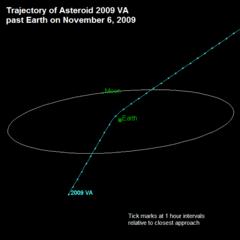2009 VA
| Discovery | |
|---|---|
| Discovered by | Catalina Sky Survey |
| Discovery date | November 6, 2009 |
| Designations | |
| none | |
| Apollo (NEO) | |
| Orbital characteristics[1] | |
| Epoch 6 November 2009 (JD 2455141.5) | |
| Uncertainty parameter 8 | |
| Aphelion | 1.9382 AU (289.95 Gm) |
| Perihelion | 0.91768 AU (137.283 Gm) |
| 1.4280 AU (213.63 Gm) | |
| Eccentricity | 0.35735 |
| 1.71 yr (623.26 d) | |
| 338.95° | |
| 0° 34m 39.396s /day | |
| Inclination | 7.5411° |
| 224.54° | |
| 223.99° | |
| Earth MOID | 0.000130811 AU (19,569.0 km) |
| Jupiter MOID | 3.30322 AU (494.155 Gm) |
| Physical characteristics | |
| Dimensions | 7 m |
| 28.6 | |
|
| |
2009 VA is an asteroid that came within 14,000 kilometres (8,700 mi) of Earth on November 6, 2009 making it the 3rd closest non-impacting approach of a cataloged asteroid.[2] With a diameter of only 7 metres (23 ft), scientists think that even if it had been on a direct collision course with Earth, it would have likely burned up in the atmosphere.[3] The space rock made its pass by Earth just fifteen hours after its discovery.[4]

The trajectory of the object as it passed Earth.
The asteroid was first discovered by the Catalina Sky Survey at the University of Arizona. It was determined that the object would make a pass well within the orbit of the Moon, but would not strike Earth. The object passed so close to Earth that its orbit was modified by Earth's gravity.[4]
See also
- 2008 TC3
- 2010 RF12, 2010 RX30, 2010 TD54 - a similar-sized asteroids that passed Earth in 2010
- List of notable asteroids#Record-setting close approaches to Earth for other, closer approaches
References
- ↑ "JPL Small-Body Database Browser: (2009 VA)". Jet Propulsion Laboratory. Retrieved 31 March 2016.
- ↑ "Small Asteroid 2009 VA Whizzes By Earth". Science Daily. Archived from the original on 15 November 2009. Retrieved 2009-11-11.
- ↑ Small Asteroid Spotted Flying Close To Earth, redorbit.com, November 11, 2009
- 1 2 Alan Boyle. "Space rock buzzes past Earth". MSNBC. Archived from the original on 14 November 2009. Retrieved 2009-11-11.
External links
- Small Asteroid 2009 VA Whizzes By The Earth
- JPL Small-Body Database Browser: (2009 VA)
- 2009 VA at the JPL Small-Body Database

This article is issued from Wikipedia - version of the 9/12/2016. The text is available under the Creative Commons Attribution/Share Alike but additional terms may apply for the media files.